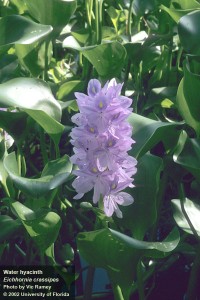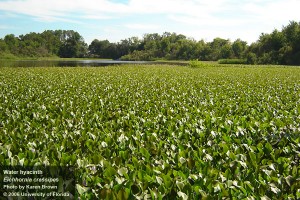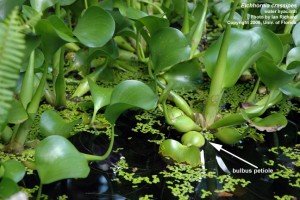UF IFAS Escambia County Extension
Northwest Florida can be a pond owner’s paradise. There is usually enough rainfall to keep ponds filled, catfish, bass, and brim are well adapted to the environmental conditions, and there is a long season to catch fish.
One of the biggest problems pond owners face is the constant struggle with pond vegetation. Some pond vegetation is good. It provides a cover for young fish, helps stabilize the shoreline or bank, and some vegetative species are attractive wildlife.
However some species are highly invasive and can completely overtake a pond. One such species is water hyacinth (Eichhornia crassipes).
The water hyacinth is a floating plant, which if left unchecked and allowed to grow to its maximum potential, can weigh up to 200 tons per acre of water. In rivers, it can choke out other vegetation and make navigation difficult to impossible.
Water hyacinth, as an ornamental plant, is a wolf in sheep’s clothing. The plants intertwined and form huge floating mats which can root on muddy surfaces, as seen in the photo below.
The plant will be several inches tall, has showy lavender flowers, with rounded, shiny, smooth leaves. These leaves are attached to spongy stalks that help keep the plants afloat. The prolific roots are dark and feathery.
In Northwest Florida this pest commonly dies back in the winter. Unfortunately it is able to regrow when the weather and water warm.
Water hyacinth is not a native species. It is believed to have been introduced into the U.S. in 1884 at an exposition in New Orleans. Within 70 years of reaching Florida, the plant covered 126,000 acres of waterways (Schmitz et al. 1993).
Water hyacinth is on the FL DACS Prohibited Aquatic Plant List – 5B-64.011. According to Florida Statute 369.25, “No person shall import, transport, cultivate, collect, sell, or possess any noxious aquatic plant listed on the prohibited aquatic plant list established by the department without a permit issued by the department.”
To control a small infestation, the plants can be gathered from the surface, brought to the shore, left to dry and then disposed of in the garbage. There are biological control options—water hyacinth weevils will be useful in keeping the plant populations down.
Finally, chemical herbicide options may be the best alternative. University of Florida Aquatic Vegetation Specialist, Dr. Langeland, wrote Efficacy of Herbicide Active Ingredients Against Aquatic Weeds, a good publication that will help you to determine which herbicide will work best for different weeds.
NOTE: The middle of the summer is generally not the ideal time for applying herbicide on pond vegetation. For more information on weed control in Florida ponds, please see Weed Control in Florida Ponds. If you have any questions about identifying a pond weed, contact your local county Extension agent.



